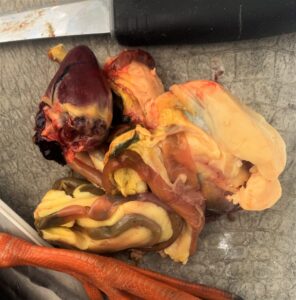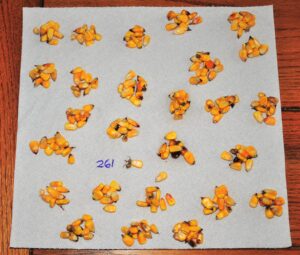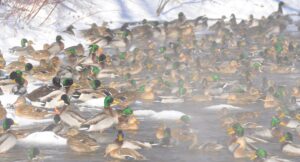Photography courtesy of Lowell Washburn, all rights reserved.
We’ve all heard that oft repeated ditty — How much wood can a woodchuck chuck?
Well, maybe it’s time to put a new spin on that old line by begging the question — How much corn can a greenhead guzzle?
The question came to mind while recently enjoying a late January falconry duck hunt along a partially open creek in extreme northern Iowa. When I flushed a flock easily containing more than 200 mallards my goshawk, Attila, selected a fine greenhead and pulled it from the sky. Rushing to the scene, I quickly traded the duck for a squirrel leg.
It was late in the day and the ducks had already returned from their afternoon feeding forays to nearby corn stubble. As is usual for late-in-the-day hunts, the drake’s crop was bulging with corn. It amazes me how, regardless of snow cover, foraging mallards always seem to find adequate amounts of shelled corn. Despite having endured an extremely cold and windy January, locally wintering mallards have remained hog fat. Not sure how they do it, but even in extreme northern Iowa, ducks rarely, if ever, go to bed hungry.

So how much high energy waste grain does it really take for carbo-loading mallards to maintain peak body condition during prolonged sieges of subzero weather? Curiosity peaked, I attempted to address the question.
Upon arriving home, I began cleaning the drake by emptying the contents of its crop and gastro system into a zip lock bag. Putting the contents on a digital scale, I discovered that the duck had consumed 3.51 ounces of grain. The daily ration contained 261 kernels of corn.

Here We Go: There are 31 days in January. If that drake were to consume 3.5 ounces of waste grain every day, it would add up to a total of 108.5 ounces or 6.78 pounds of corn per month. A lot of my winter duck hawking takes place on three areas of open water along a two-mile stretch of a fast-moving creek. This year, those waters have contained a continuously intermingling flock containing between eight hundred and nine hundred mallards. On most days, the ducks continue to feed within a two-mile radius of the creek which indicates that there is still plenty of food scattered on the ground.
Taking a conservative approach, let’s say that only 800 of those ducks manage to glean their 3 ½ ounce ration of grain per day. That would mean the flock would consume an incredible 2.71 tons of corn per month – and we intentionally left around 100 ducks out of the equation.

Final Thought: Before any of you PhD-ers get your hackles up, let me say that I won’t be submitting my impromptu waste grain math jam to the Academy of Science any time soon. I’ll also admit that I’m not a super phenomenal numbers cruncher; the statistical gene is completely missing from my DNA profile. But having said that, I also don’t think the estimates are necessarily that far-fetched either.
There are at least a couple of certainties in all this – Despite the weather, our wintering mallards have managed to remain in prime condition. The second certainty is that I’d definitely hate to be feeding those ducks out of my personal check book. If the same amount of shelled corn was purchased from local grain outlets, it would cost a minimum of $1,140 per month to keep those mallards smiling.



 Susan Judkins Josten
Susan Judkins Josten Rudi Roeslein
Rudi Roeslein Elyssa McFarland
Elyssa McFarland Mark Langgin
Mark Langgin Adam Janke
Adam Janke Joe Henry
Joe Henry Sue Wilkinson
Sue Wilkinson Tom Cope
Tom Cope Kristin Ashenbrenner
Kristin Ashenbrenner Joe Wilkinson
Joe Wilkinson Dr. Tammy Mildenstein
Dr. Tammy Mildenstein Sean McMahon
Sean McMahon